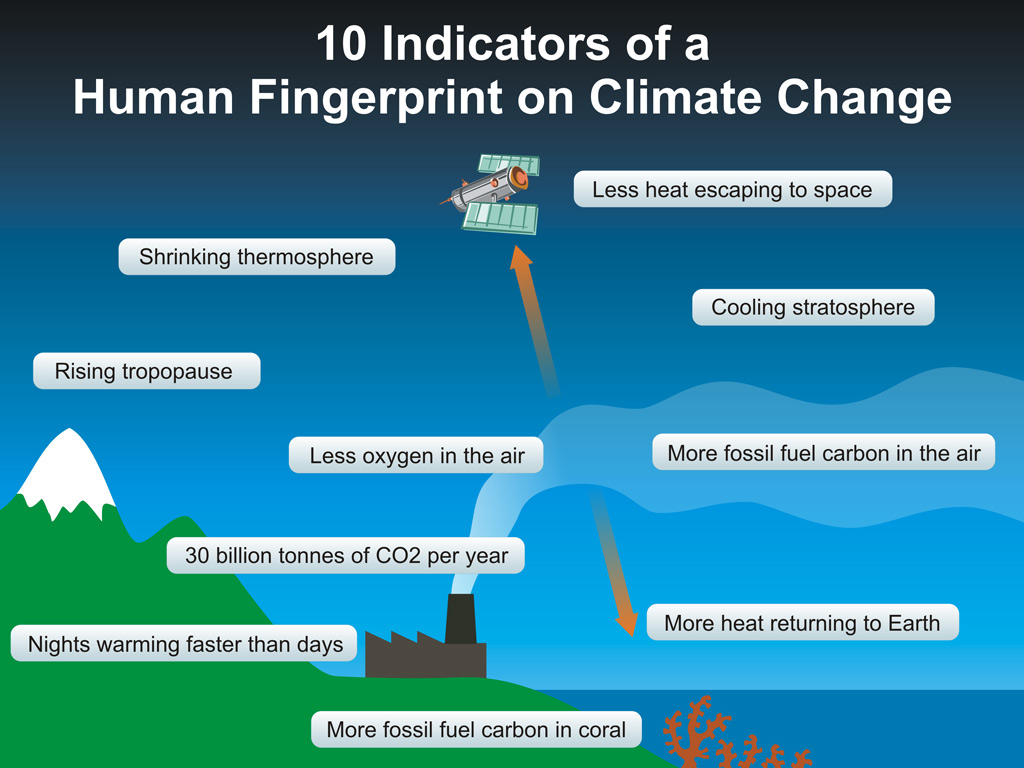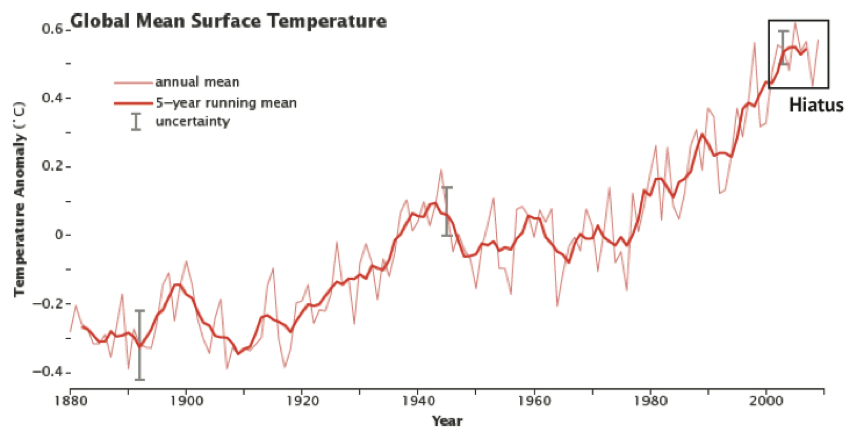Human Fingerprints on Climate Change Rule Out Natural Cycles
Posted on 16 November 2020 by Kai Huang
This post is an updated intermediate rebuttal to the myth "global warming is caused by natural cycles". It was written by Kay Huang as part of the George Mason University class Understanding and Responding to Climate Misinformation, combining climate science and communication best practices to debunk common climate myths.
Global warming refers to the long-term warming of global temperature since the 1850s. The cause of global warming has been investigated by many scientists, who have summarized their finding in multiple assessment reports by the Intergovernmental Panel on Climate Change (IPCC). The only plausible mechanism of global warming is a planetary energy imbalance, with our climate system building up heat. This and the observed fingerprints left on global warming confirm the dominant role of human activities.
Fossil fuel burning is causing recent global warming
Scientists have identified two factors that drive global climate change: internal variability and external forcings. Internal variability refers to the internal processes moving heat around within the climate system. External forcings cause an energy imbalance - with the planet either building up or losing heat - and can be both natural and human caused. The only plausible mechanism accounting for the long-term temperature increase of global warming is through a buildup of heat in the climate system (Li et al., 2007).
Among the various external forcings that can cause the climate system’s energy imbalance, scientists have concluded the main cause of recent global warming is the increase of atmospheric CO2 due to fossil fuel burning.
In order to understand how scientists came to the above conclusion, it is important to understand the various drivers of climate changes.
Internal variability moves heat around the climate system
Climate change is like the motion of water in a kitchen sink with an inflow from the faucet and an outflow through the drain. The motion consists of both the water sloshing around and the rising and falling of water level. The random sloshing around is what scientists call "internal variability," while the rising and falling of water level is what scientists call "forced variability". Internal variability (e.g., ocean cycles such as El Niño South Oscillation, Pacific Decadal Oscillation, and Atlantic Multidecadal Oscillation) moves heat around to give rise to regional climate change on timescales ranging from annual to millennial timescales. Like the water sloshing around, internal variability doesn't build up or dissipate the total amount of heat in the climate system. In contrast, external forcings (e.g., 11-year solar cycle and changes in the Earth’s orbit) change the climate by causing a buildup or loss of heat, similar to the change in water level being determined by the difference between the inflow and outflow.
The single cause fallacy committed by the natural cycle myth
One climate myth argues that recent global warming is caused by natural cycles rather than human activity. The so-called “natural cycles” in the myth may include climate variation due to internal variability or external forcings. Natural external forcings, such as the 11-year solar cycle and changes in the Earth’s orbit, are part of nature and not influenced by human activities. Other external forcings like greenhouse gases and aerosol concentrations in the atmosphere are significantly influenced by human activities, and thus are excluded from natural cycles.
The argument that global warming is due to natural cycle commits single cause fallacy, by assuming there is only one driver of climate change (e.g., natural factors) when there may be others (e.g., human activity). In this case, the myth argues that the same factors, namely internal variability and natural external forcings, that drove past natural cycles must also be the same factors causing current global warming. But the fact is that humans have emitted large amounts of CO2 into atmosphere by burning fossil fuel since the industrial revolution, and it is the main cause of recent global warming.
One version of this myth is that the natural cycles may cause cyclic climate change with timescales ranging up to millennial timescales, and therefore recent global warming is just the rising phase of such a cycle. However, this argument is ruled out by the observed fingerprints on global warming (seen in Figure 1) since no natural cycles fit all these fingerprints. For example, natural cycles cannot explain why the satellites measures less heat escaping to space at the precise wavelengths which CO2 absorbs (Philipona 2004, Wang 2009).
The observed fingerprints on global warming and the fact that only external forcings can cause a buildup in heat in the climate system work together to not only rule out natural cycles, but also confirm that the anthropogenic CO2 increase in the atmosphere is the main cause of modern global warming.

Figure 1: Schematic of the fingerprints on global warming (Skeptical Science).
Internal variability does NOT build up heat
Internal variability changes the global mean surface temperature by moving heat around inside the climate system without changing the total amount of heat for any sustained period in time. Some internal variabilities, such as the Pacific Decadal Oscillation, can transfer heat from the ocean’s upper layers to the deep ocean. As a result, more heat is moved to the deep ocean and the global mean surface temperature decreases (Douville et al., 2015). Burying all this heat in the deep ocean led to a stagnation of global warming from 2000 to 2015, known as the so-called global warming hiatus (shown in Figure 2).
However, the heat hadn't left the climate system. When ocean cycles shifted to a different phase, the buried heat in the deep ocean was released to the ocean upper layers, causing an increase in the global mean surface temperature. We saw this rebound in warming with 2014, 2015, and 2016 being the hottest years on record. Natural cycles from internal variability only results in cyclical fluctuations and are not the driver of long-term global warming.

Figure 2: This temporary plateau in temperatures has been referred to as a hiatus. Adapted from NASA Earth Observatory.
Since internal variability does not change the climate system’s energy balance and long-term warming requires a buildup in heat, the cause of the global warming can only be changes in external forcings. But which exact external forcing?
Fingerprints confirm fossil fuel burning is the main cause
The main external forcing driving global warming has to explain the observed “fingerprints”. One of these fingerprints is the troposphere (the lowest part of the atmosphere) warming with the stratosphere (the upper levels of the atmosphere) cooling. Greenhouse gases build up heat by trapping the outgoing radiation on Earth without changing the incoming energy. As most of the greenhouse gases occupy the lower troposphere, they act like a blanket covering the surface. As a result, warming caused by increasing greenhouse gases starts from the lower atmosphere, namely troposphere (Liou 2002). This fingerprint also rules out the sun as a possible cause of warming as increased solar energy would heat the whole atmosphere.
The amount of received solar radiation also varies with changes in the Earth's orbit. These are referred as Milankovitch cycles. They occur on very long-time scales (10,000+ years) and cannot explain the warming over the past 100 years. In addition, direct measurements show an increased greenhouse effect. The only explanation that fits the observed evidence is the increase in greenhouse gases.
The increase in greenhouse gases in the atmosphere is caused by human activities rather than natural processes. For example, CO2 emission from volcanoes is small compared to anthropogenic emissions. Although the ocean emits large amount of CO2, it actually absorbs more CO2 than it emits, including anthropogenic CO2 (Falkowski and Wilson 1992). So, the net effect of CO2 natural cycles are quite small. In addition, CO2 from fossil fuels has its own fingerprints. Fossil fuels contain less of the carbon-13 isotope, which explains why the atmospheric ratio of carbon-12 to carbon-13 has been increasing as more anthropogenic carbon dioxide gets added to the atmosphere. Additionally, atmospheric oxygen (O2) is decreasing at the same rate that CO2 is increasing, because oxygen is consumed when fossil fuels burn.
Therefore, the only cause of global warming that both makes sense from a physics point of view and fits the observed global warming “fingerprints” is increase in CO2 from fossil fuel burning.
The climate myth viewing global warming as a natural cycle distorts the fact with a single cause fallacy. Before the 1850s when human influence on climate was almost negligible, natural cycles were the dominant drivers of the global temperature changes. But currently, with large amounts of fossil fuel burned since the industrial revolution, the global mean surface temperature is showing an obvious increasing trend apart from what can be explained by natural cycles. The natural cycles can still explain these fluctuations superimposed over the trend but fails to explain the continuously increasing trend itself. The main cause of recent global warming is the increasing anthropogenic CO2 in atmosphere.































 Arguments
Arguments






























What always bugs me is when deniers say that xx Million years ago the CO2 was yyy and the temperature was ZZZ and THEREFORE blah blah blah so we cannot believe the scientists.
When it's pointed out that unless they have some unknown source for their figures they come from SCIENCE - the very same SCIENCE that they won't believ - as usual they change the subject to another myth.
Can't win.
Wol @1,
The 'many thousands' of ppm CO2 in the distant past do make for a pretty powerful message. Of course, as you say, it is not inconsistent with the same science that says AGW will be a problem at 'several hundred' ppm CO2. The IPCC scenario RCP6.0 is so-named because by 2100AD it will have provided a climate forcing of 6W/m^2.
And while the CO2 levels were indeed up at perhaps 2000ppm 200My ago and perhaps even 6000ppm 500My ago, the sun was weaker back then and the CO2 effect is logarithmic, so the resulting climate forcing those hundreds-of-millions of years ago was less than the forcing we are set to deliver over the next 100 years. (The SkS post 'Do high levels of CO2 in the past contradict the warming effect of CO2' presents this graphically.)
And the SkS post doesn't account for the changing geography of the planet which is alos a big factor. CO2 hasn't been anything like todays' level for 3 million years, back when N & S America were yet to join together. And to find CO2 higher than today, it is 13 million years ago when the Himalayas were still being formed.
The denialist will push simple stuff (like CO2 was once thousands of ppm) but they tend not to be well versed in the full story - because if they were, they wouldn't be deniers.
Towards the end of the '90's, the idea that maybe scientists were unawares of what constituted the planet's natural cycles over Earth's long history occurred to me, so I went looking, and quickly found something that answered my questions/doubts: paleoclimatology.
So this latest nonsense was in the ether, as it were, more than twenty years ago - so tired of going backwards, discussing the same things agaian and again - don't see the advantage to any but the already wealthy.
In the context of the OP, would it appropriate to include Catastrophic Weather Events as an Indicator of the Human Fingerprint of Climate Change? Ditto for the Melting Cyrosphere.
I wonder whether the "nights warming faster than days" fingerprint should be more nuanced? This page
https://news.yahoo.com/summer-swelter-trend-west-gets-134723813.html
says days, in the American west, are warming faster than nights.